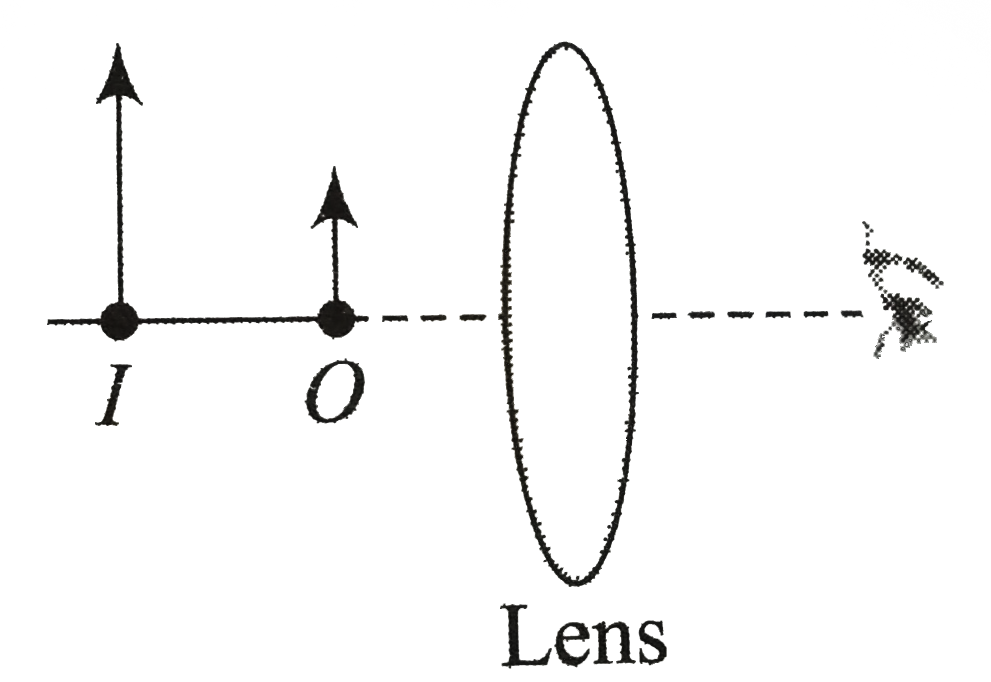A wire mesh consisting of very small squares is viewed at a distance of 8cm through a magnifying converging lens of focal length 10cm, kept close to the eye. The magnification produced by the lens is:
5
8
10
20
The correct Answer is:A
To solve the problem of finding the magnification produced by a magnifying converging lens, we will follow these steps:
1. Identify the Given Values:
- Focal length of the lens, f=10cm (positive for converging lens)
- Object distance, u=−8cm (negative as per sign convention)
2. Use the Lens Formula:
The lens formula is given by:
1f=1v−1u
Substituting the known values into the lens formula:
110=1v−1−8
This simplifies to:
110=1v+18
3. Rearranging the Equation:
To find 1v, we can rearrange the equation:
1v=110−18
To perform this subtraction, we need a common denominator. The least common multiple of 10 and 8 is 40:
110=440and18=540
Therefore:
1v=440−540=−140
4. Calculate the Image Distance v:
Taking the reciprocal gives us:
v=−40cm
The negative sign indicates that the image is virtual and located on the same side as the object.
5. Calculate the Magnification M:
The magnification M is given by the formula:
M=vu
Substituting the values of v and u:
M=−40−8=5
Final Answer:
The magnification produced by the lens is M=5.
---
- Focal length of the lens, f=10cm (positive for converging lens)
- Object distance, u=−8cm (negative as per sign convention)
The lens formula is given by:
1f=1v−1u
Substituting the known values into the lens formula:
110=1v−1−8
This simplifies to:
110=1v+18
To find 1v, we can rearrange the equation:
1v=110−18
To perform this subtraction, we need a common denominator. The least common multiple of 10 and 8 is 40:
110=440and18=540
Therefore:
1v=440−540=−140
Taking the reciprocal gives us:
v=−40cm
The negative sign indicates that the image is virtual and located on the same side as the object.
The magnification M is given by the formula:
M=vu
Substituting the values of v and u:
M=−40−8=5
The magnification produced by the lens is M=5.
Similar Questions
A cardsheet divided into squares each of size 1mm2 is being viewed at a distance of 9cm through a magnifying glass (a conerging lens of focal length 10cm) held close to the eye.
(a) What is the magnification produced by the lenas ? How much is the area of each square to the virtual image ?
(b) What is the angular magnification (magnifying power) of the lens ?
( c) Is the magnification in (a) equal to the magnifying power in (b) ? Explain
View SolutionThe distance between an object and a divergent lens is m times the focal length of the lens. The linear magnification produced by the lens is
View Solution
Knowledge Check
A square card of side length 1 mm is being seen through a magnifying lens of focal length 10 cm. The card is placed at a distance of 9 cm from the lens. The appaent area of the card thorugh the lens is
A1cm2B0.81cm2C0.27cm2D0.60cm2
Distance of an object from a concave lens of focal length 20 cm is 40 cm. Then linear magnification of the image
View SolutionAn object is placed at a distance 24 cm in front of a convex lens of focal length 8 cm.
Calculate the distance of the image from the lens.
View SolutionA man wishes to view an object through a convex lens of focal length 10cm. The final image is to be eret and magnified 2 times. How far from the object must he hold the lens?

View SolutionAn object is kept at a distance of 15 cm from a convex lens of focal length 10 cm. Calculate the image distance and state the characteristics of the image formed.
View SolutionA convex lens of focal length 30 cm produces 5 times magnified real image of an object. What is the object distance?
View SolutionAn object O is kept infront of a converging lens of focal length 30 cm behind which there is a plane mirror at 15 cm from the lens.
_E01_080_Q01.png)
View SolutionAn extended real object of size 2cm is palced perpendicular to the principle axis of a converging lens of focal length 20cm. The distance between the object and the lens is 30cm
(i) Find the laterial magnification produced by the lens.
(ii) Find the height of the image.
View Solution
